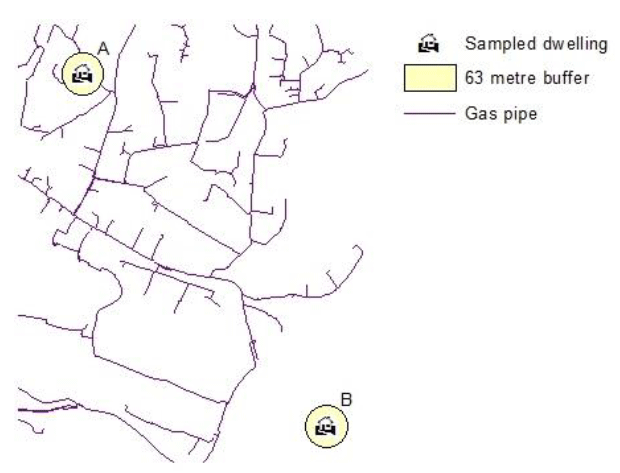Scottish House Condition Survey: Methodology Notes 2019
Information on the definition and methods of derivation of key indicators measured through the Scottish House Condition Survey (SHCS) which apply to the reporting of 2019 data.
This document is part of a collection
7. Gas Grid
106. Gas network coverage reported in the 2019 SHCS Key Findings report is determined on the basis of the distance between the dwelling and low/medium pressure gas distribution pipes. The information on the location of low and medium pressure gas distribution pipes is provided by Scotia Gas Networks who operate the gas distribution network in Scotland. This data includes both the national gas network and the Scottish Independent Undertakings (SIU). An SIU network is a town gas supply, owned and managed by Scotia Gas Networks, but which is not connected by pipeline to the rest of the gas grid.
107. The geographical location of sampled dwellings is recorded as part of the SHCS collection. It is therefore possible to compare directly the location of dwellings in the SHCS with the location of gas distribution pipes in the Scottish network. A dwelling which is within the usual maximum distance for a standard domestic gas connection is considered to be covered by the gas grid.
108. In order for a property to be eligible for a standard domestic gas connection, the property boundary must be within 23 metres from the gas pipe, and the gas meter must be within 40 metres from the property boundary, as set out in the SGN guidance.
109. The SHCS does not contain information regarding any land surrounding a dwelling. It is only therefore possible to measure the distance from the building centroid to the gas pipe, and not the property boundary.
110. This gives two options for selecting a threshold value for distance from the gas grid beyond which the dwelling is considered 'off-grid':
111. Option A. Set a threshold value equal to the sum of the maximum distances (23 m + 40 m) and define off-grid as further than 63 m from the gas pipe. This method potentially under-counts off-grid dwellings: where a dwelling is within 63m of a pipe but its surrounding land accounts for less than 40m of this distance, it will be counted as 'on grid' even though it does not meet the usual standard connection specification. This is more suitable for measurements in rural areas where we can assume the land surrounding dwellings is larger.
112. Option B. Ignore the 40 m distance within the property boundary and set the definition of off-grid as 'more than 23 m between building centroid and gas pipe'. This may result in over-counting off-grid dwellings, because it doesn't take into consideration the land surrounding the building.
113. Since grid coverage is lower in rural areas, and rural dwellings are more likely to have surrounding land, we have opted to use 63 m as the threshold distance to determine gas network coverage (Option A). This will therefore result in a conservative measure of dwellings off the gas grid in urban areas if the density of gas distribution pipes is low.
114. When determining the distance between dwellings and distribution gas pipes, the SHCS does not include pipes owned and operated by Independent Gas Transporters (IGT). Consequently, there is a chance a dwelling connected to the gas network via an IGT will be classed as outwith the coverage of the gas grid. This could potentially increase the off-grid count, particularly among dwellings in new housing developments, which form the largest residential share of the IGT market.
115. Using GIS mapping software, dwelling locations and gas distribution pipes are plotted together. Where a gas distribution pipe does not intersect with a 63m ring around a dwelling location, that dwelling is said to be off the gas grid. In the example below, dwelling A is on the network, while dwelling B is not.

116. The gas grid coverage measure does not reflect the presence of gas supply to the building. A dwelling may be located within 63m of a gas distribution pipe and not be connected to the gas grid, and conversely, it may be further way but have a gas connection.
Contact
There is a problem
Thanks for your feedback